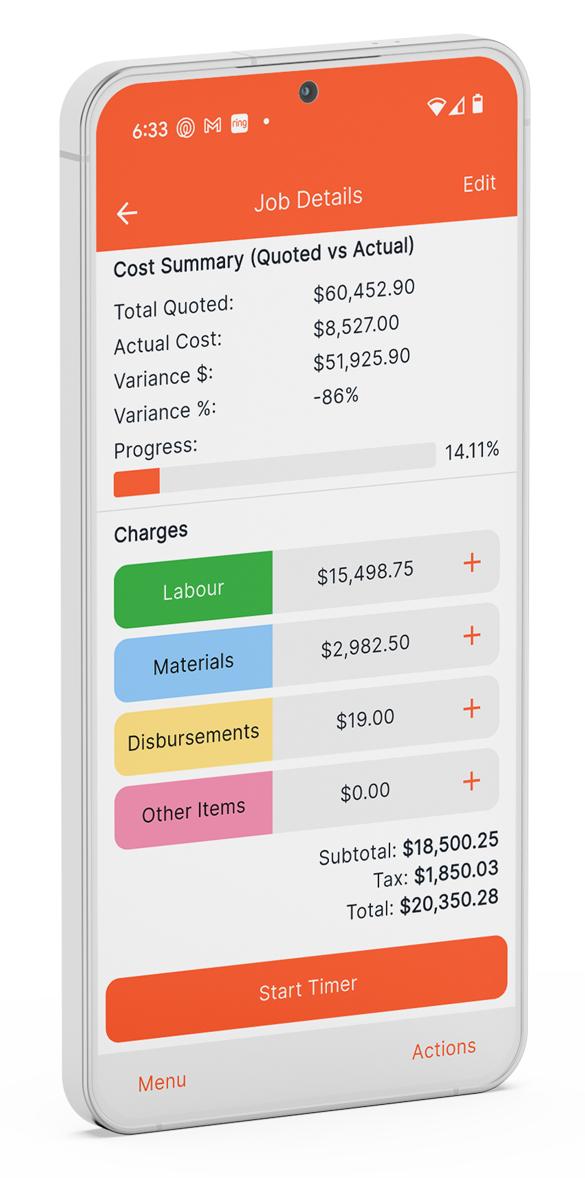Managing a building crew without the right scheduling tools is like framing up a house without a level. It gets messy fast. Whether you’re quoting a new reno, juggling subbies across jobs, or just trying to get the team on the right site at the right time, job scheduling can make or break your day.
A proper job scheduling app takes that chaos and gives you control. You can plan jobs in stages, assign tasks to the crew, see who’s doing what and when, and link it all back to quotes, timesheets and invoices.
But not all apps are made equal — especially for residential builders and related trades. Most tradie job management tools are built for quick, same-day jobs. If you’re running multi-week projects, they won’t cut it.
Let’s break down the best scheduling options out there, and why NextMinute is the only one truly built for the way Aussie builders and residential tradies work.
1. NextMinute – Made for Builders

If you’re looking for scheduling that actually matches how builders plan jobs, NextMinute is the one to beat. It’s designed specifically for Australia, supports local tax and accounting systems, and most importantly, it’s built for residential building projects.
Unlike most tradie apps that just give you a list of jobs or a basic calendar, NextMinute comes with a Gantt chart-style scheduler. That means you can break jobs into stages, add dependencies, and move things around easily. If it rains and framing gets pushed out, you just shift that stage and everything else adjusts. No double handling. No missed steps.
And because it’s all connected (quoting, timesheets, invoicing, cost tracking) you can manage the whole job from start to finish in one place.
Why it works for builders:
- Gantt chart scheduler with dependencies
- Stage-by-stage job planning for longer projects
- Easy drag-and-drop rescheduling
- Crew can log time, notes and photos via mobile
- Works with Xero, MYOB and QuickBooks
- Built-in cost tracking and back costing
Not ideal for:
One-man bands or same-day jobs — NextMinute really shines when there’s a team involved and a job to manage over weeks, not hours.
2. Spreadsheets, Whiteboards & Paper Diaries – Still Common, But Risky
Let’s be honest, plenty of builders still use Excel, whiteboards or paper diaries to run the show. And hey, if it works, it works. But when things get busy, these old-school methods fall apart fast.
They don’t update in real time. You can’t share them easily with your crew. And if someone forgets to write something down or snaps the whiteboard photo out of date, you’re in strife.
Problems with the manual approach:
- No live updates or team visibility
- Easy to double-book or forget tasks
- Hard to track costs or timesheets
- No integration with quoting or invoicing
- Time-wasting and error-prone
If you’re doing two or three jobs at once, juggling subbies and clients, it’s only a matter of time before something slips. That’s why more and more builders are ditching the paperwork for smarter tools.
3. Tradify – Good for Sparkies, Less So for Builders
Tradify is a solid job management tool, popular with plumbers and sparkies. It does quoting, job cards, invoicing and scheduling pretty well, but it’s not designed for longer, multi-stage jobs.
There’s no Gantt chart, no job dependencies, and no proper project planning features. It’s perfect for small jobs that take a few hours or a day. But try to run a six-week reno in Tradify and you’ll hit walls.
Strengths:
- Easy to use
- Great for same-day jobs and reactive work
- Handles subbie hours and invoicing
Not great for:
- Multi-stage projects
- Project planning or back costing
- Managing a team over weeks
4. Fergus – Better for Trades, Not Builders
Fergus is another well-known name, and like Tradify, it’s best suited to service trades. Plumbers, HVAC, and sparkies get a lot of use from it — especially with its strong quoting tools and supplier integrations.
But again, Fergus falls short when it comes to job scheduling for builders. No Gantt charts, no dependencies, no real planning tools. It’s more about logging jobs than managing them across stages and timelines.
Pros:
- Pulls supplier pricing into quotes
- Decent mobile app
- Solid cost tracking
Cons for builders:
- No stage-based scheduling
- Limited project management tools
- No in-app team messaging
5. ServiceM8 – Great for One-Off Jobs, Not Projects
ServiceM8 is slick, mobile-friendly, and works well for trades doing fast turnaround work. It’s an Apple-first app, great for solo tradies doing maintenance, callouts or small installs.
But again, it’s not set up for the kind of planning builders need. There’s no project view, no Gantt chart, and limited ability to manage teams across days or weeks. If you’re building anything bigger than a deck, ServiceM8 will feel too light.
Best for:
- Plumbers, electricians, cleaners
- Solo operators or small teams
- Fast jobs and mobile quoting
Drawbacks:
- iOS only (Android version is very limited)
- Not made for multi-stage jobs or construction
- No timeline view or task dependencies
6. SimPRO – Built for Big Business, Not Small Builders
SimPRO is a full enterprise system with scheduling, asset management, inventory and everything in between. It’s powerful — but it’s also complex and expensive.
If you’re running a large company with 50 staff, it might be worth looking into. But for most small to mid-sized builders, it’s overkill.
Good for:
- Large commercial operations
- Fleet management
- Multi-site scheduling
Not ideal for:
- Simpler residential builds
- Builders looking for something easy to use
- Smaller teams without dedicated admin staff
What Should You Be Looking For?
If you’re a builder in Australia looking for scheduling software, here’s what actually matters:
- Can I plan out a job in stages?
- Can I assign tasks to the right people?
- Will the schedule adjust if something moves?
- Can I link it to my quotes, timesheets and invoicing?
- Is there a mobile app that’s actually good?
- Is it designed for construction, not just quick fix-it jobs?
NextMinute ticks all of those boxes. And you’ll be working with a local Aussie team who understand how your business works — from weather delays to GST to clients who want a new feature added halfway through a job.
Final Word
Most scheduling tools out there were built for service tradies doing small jobs. And that’s fine, but it’s not what builders need.
If you’re running jobs with a crew, materials, timelines, delays and stages, you need more than a glorified calendar. You need a job management system that actually fits the way Aussie builders work.
NextMinute was built for that. Scheduling, quoting, timesheets, invoicing, reporting — all under one roof. Gantt charts when you need them, mobile app for the team, and local support when you get stuck.
Want to stop running your business off a whiteboard and start managing like a pro?
Try NextMinute today — and see how much smoother your scheduling can be.



.avif)









